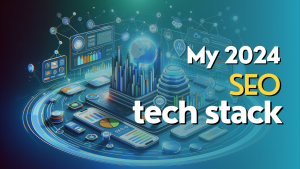AI Overviews are here to stay, so it’s worth taking some time to discuss where they may be heading over the next 12 months.
I have some predictions about AIOs I would like to share.
The predictions come from observing Google over the past 25 or so years. I have made predictions in the past about Google and I think I have been right more often than I have been wrong.
For example, I predicted we would see something like both Panda and Penguin a full year before they were released, but I did not predict just how intense those updates would be.
I predicted years ago that Google would continue moving towards being more of a semantic search engine, which was why I so heavily started using silos (they are really just what people refer to today as topic clusters) 15+ years ago.
On the other hand, I also predicted some time ago that Google would pull back from their plan to unleash SGE (now AIOs) on the public, so I’m not always right.
I don’t say this to brag, but just to give some context.
So what might we see in the next year from Google in regards to AI Overviews?
Prediction #1 – Featured snippets will be deprecated
As Google generates more and more AIOs for search queries, featured snippets will be redundant.
You can already see this in SERPs where both an AI Overview and featured snippets appear.
Featured snippets don’t really offer anything that AIOs are not providing to a searcher.
I know people will point to how many AIOs are out there that give incorrect or bad answers.
But have there not been featured snippets that have done the same?
I would also argue that since their initial launch, Google has improved the content we see in AIOs pretty dramatically. Are they perfect? No, of course not, but they are quickly getting to a place where they will make featured snippets nothing but wasted space on the SERPs.
What featured snippets going away will mean for SEOs
I think where this will hurt organizations the most is in brand recognition.
Featured snippets are generally not a great way to drive traffic to a website. They often provide people with the information they were looking for. In some cases, searchers do click on the link and move to the site.
What featured snippets can be great for is establishing authority and brand recognition to an audience. When I say authority, I’m not talking about authority in terms of search engines. I’m talking about expertise; establishing yourself or your organization as a source of truth, information, and/or thought leadership within a niche.
If you can capture a lot of snippets within a topic, people who are doing frequent searches in that space will see your results over and over at the top and begin to associate you with a leader in that market.
If you do have featured snippets that you rely on for search traffic, I would start experimenting and testing now how you can get cited in AIOs to lessen the impact them going away may have.
Prediction #2 – Expanded vertical coverage & real-time data
AI Overviews already saw a massive uptick in entertainment, restaurant, and travel queries during Google’s March 2025 core update. By mid-2026, expect AIOs to pull live sports scores, stock tickers, flight statuses, and local weather straight into the summary, powering “one-stop” overviews across every major vertical.
3 ways this expanded coverage and real-time data could impact SEO:
Structured data & schema markup become mission-critical
To earn inclusion in real-time AI Overviews, publishers must adopt the relevant schema types—such as WeatherForecast, SportsEvent, FlightStatus, and StockQuote—and keep them continuously up to date. Google has repeatedly shown that pages with rich, accurate structured data see dramatically higher engagement: sites implementing JSON-LD markup have measured up to 25% higher CTR on rich results versus non-marked pages.
Content strategy refocus on analysis & commentary
With raw data delivered in-SERP, the value proposition for traditional informational pages shifts toward expert analysis, long-form commentary, and unique insights. Sites that simply report live scores or stock prices will struggle even more for traffic, whereas those that add interpretation, trends, and forecasts can still drive clicks and retain audience engagement.
Shift toward data partnerships & API feeds
Because real-time overviews rely on live data feeds, major publishers in travel, finance, and sports may need to establish formal API partnerships (or contribute to Google’s data ecosystem) to ensure their information is the freshest and most reliable. SEO teams will increasingly work alongside engineering and product teams to expose real-time endpoints that Google can ingest.
Prediction #3 – Google will introduce AI chat into AI Overviews
This is a simple a logical next step for AI Overviews and something I think could dramatically impact Google Search.
Rather than people refining their searches like they have in the past in the Google search bar, we will see people have the option of asking Google’s AI clarifying questions about their search and having a chat just like you do now in ChatGPT, Gemini, Claude, etc.
At Google I/O 2024, Google announced that AI Overviews would gain multi-step reasoning and “adjustment” controls allowing searchers to simplify, expand, or drill down on an AI-generated summary right in the search results. What this really means is that you’ll be able to carry on a mini-conversation with Search, asking complex, nuanced questions (e.g. “Find the best pilates studios in Boston, show me intro discounts, plus walking times from Beacon Hill”), all without leaving the AI Overview box.
More recently, Google began rolling out “AI Mode” in Search. Accessible via its own tab ahead of Web, Images, Video, etc., AI Mode provides a ChatGPT-style interface grounded in Google’s index, complete with follow-ups, saved conversation history, and visual “cards” for businesses or products.
This doesn’t replace AI Overviews; it complements them by offering a deeper chat experience for queries where a back-and-forth is useful. Google has even lifted the waitlist for this feature in Labs, signaling a broader rollout soon.
What AI chat in AI Overviews will mean for SEOs
This one could fundamentally change the way people use Google search for a lot of their queries.
The most difficult part of this from an SEO point of view is going to be the lack of data. It’s similar to the challenges we see right now from people using LLMs like ChatGPT. You can measure how much traffic you are getting directly from ChatGPT Google Analytics or whatever analytics tool you are using, but you cannot see what brought them there.
Perhaps we will see query data for their initial search in GSC, but we aren’t going to get data on the full conversation that may have led them to clicking over to our websites. Or at least Google has not stated any reporting changes in the near future.
The ability to ask follow-ups (“Where’s the nearest studio with intro discounts?”, “Drill down on server requirements”) means content must be modular and anticipate multi-turn queries.
Crafting clear, context-rich answer snippets, such as bullet-pointed pros/cons, comparison tables, or step-by-step overviews, can help ensure your content is drawn into iterative AI chat flows.
Bottom line: AI chat in AI Overviews will reduce some traditional organic traffic, shift emphasis toward semantic and entity-driven content, and require new optimization tactics, focused on structured data, brand reputation, and multi-turn conversational readiness, to maintain visibility and engagement in Google’s evolving search landscape.
Prediction #4 – Conversational commerce & transactions will be completed in AIOs
This will be the follow-up evolution of AI chat in AI Overviews.
Google CEO Sundar Pichai’s roadmap hints at embedding Gemini into “paid partnerships” much like Ads in classic Search, so AIOs will evolve from pure summaries into transaction, capable chats. You might reserve a table, buy a train ticket, or subscribe to a service entirely within the Overview interface, without ever clicking through.
3 ways conversational commerce & transactions in AIOs will impact SEO:
Site-side readiness & headless commerce
- API-first architecture: To support real-time inventory checks and bookings, your backend must expose headless commerce endpoints (GraphQL/REST) that Google’s agents can query on demand.
- Latency & reliability: Conversational transactions demand millisecond-level responses; slow or error-prone APIs will drop you out of the AI flow.
From click-through to in-interface conversions
- Fewer click-outs: As users can complete purchases, bookings or reservations directly within the AI Overview chat, traditional “visit my site” CTAs lose prominence.
- Optimize for on-SERP actions: You’ll need to ensure your product inventory, booking slots or service availability is surfaced via Google’s Commerce Graph or Reserve with Google APIs—so that your offerings appear as selectable options in the dialogue.
Query intent becomes more granular
- Micro-intents: Instead of “best hiking boots” you’ll see “reserve hiking boot fitting next Tuesday” or “add men’s size 10 trail runners to cart.” SEO must pivot from broadly informative pages to ultra-targeted landing experiences that map exactly to these micro-intents.
- Content modularization: Break pages into discrete, self-contained “action units” (e.g. product selector widgets, availability calendars) that can be stitched together in a conversational flow.
It’s a wild time to be in SEO. Think about how much things have changed in the past 12 months and how different they will be 12 months from now.

